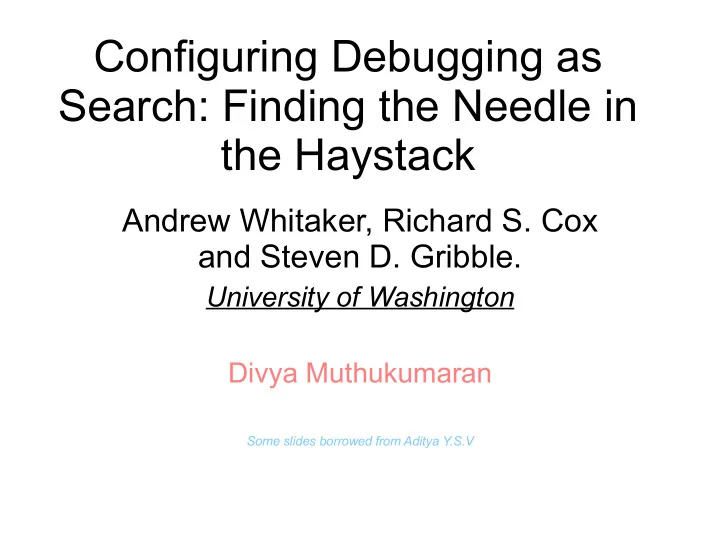

Configuring Debugging as Search: Finding the Needle in the Haystack Andrew Whitaker, Richard S. Cox and Steven D. Gribble. University of Washington Divya Muthukumaran Some slides borrowed from Aditya Y.S.V
Whats the big picture? • Can we automate some of the diagnostic tasks of the system administrator ? • This paper – Partial automation of diagnosis!
Configuration Debugging • Configuration changes can cause system failure – Dynamic library upgrades – Installing an incompatible library – Windows Registry Modifications – Security policy change • What caused the failure?
Configuration Debugging • This work addresses the problem of diagnosing configuration errors that cause a system to function incorrectly. • The basic idea is to search for the time when the system transitioned to a failed state. • The paper presents a tool CHRONUS which automates this.
Motivation 1970’s Total ownership cost breakdown Hardware costs 2000’s People costs • System experts are expensive!
Existing Approaches • Prevention: Complex systems, Difficult to anticipate side-effects of change • Recovery: Windows XP restore. The problem with this is that it is a transition in itself and so it isn’t always safe. • Expert Systems: “Static Database” of known error configurations. Correction from this can be automated. – Complex systems -> complex rule database
The Basic Approach System Why? failure Chronus External When? analysis tools
System Overview • Chronus reveals when a system failed failure transition Time system was system was working NOT working • Chronus pro-actively logs system states
System Overview Design components Design choices Time travel disks, Time Travel virtual machines Software probes, Testing copy-on-write disks Search Binary search
Time Travel • Persistent vs. Transient state captures • Chronus :- Only persistent storage. – Lacks Completeness – Less Overhead • Some configuration changes need system restarts.
Virtual Machines • The various states are checked by doing a virtual reboot of the system. • Virtual reboot is faster than physical reboot • Good way for terminating failed tests.
Disadvantages of VM • Performance Overhead • May not be able to expose the latest devices and device drivers • Cannot diagnose errors within the virtualization layer itself such as updates to physical device driver.
Testing • Automated diagnosis uses a user supplied “ software probe ” • Written on the fly • It has a manual method of software probe if all you remember is a series of GUI actions
Search • Binary search • Spurious Errors – Implicate a past upgrade • Strategy to overcome spurious errors. – Run Chronus several times. – Different time ranges for each search
Binary Search transition Time system was system was working NOT working
Phase #1: Normal operation Time-travel disk disk requests Parent Child Virtual Machine Virtual Machine μ Denali Virtual Machine Monitor • Child VM runs normal user programs • Parent VM records disk writes to a time-travel disk – Each block write represents an instant in time
Phase #2: Debug Mode User command: search T begin T end Was the system Disk correct? Time-travel Disk (T begin ) probe disk Parent requests Child Virtual Machine Virtual Machine µ Denali Virtual Machine Monitor
Testing • Internal and external probes • Pre-processing - wrap TTDisk with a Copy-on-write disk • Execute the probe on boot • Halt the child VM • Mount the COW disk and do post processing
Implementation • Command-line interface • Search (TTDisk, Range log indices, probe) • Attach - Mounts child system before and after state change • diff - What precise change caused the failure?
Debugging experience - sshd • Fault-injection: Random configuration errors • sshd doesn't respond to remote login requests • Probe: login via ssh and execute the UNIX date command
Binary search failure transition Time system was system was working NOT working
Debugging experience: sshd transition Time system was system was working NOT working
Debugging Experience- sshd • >>> attach andrew.time 4919 4920 • >>> diff -r /child1 /child2 – Binary file /etc/ssh/ssh_host_key differs
Case Study: Mozilla Web Browser • Mozilla Web Browser on the NetBSD OS • Does Chronus apply to all errors? – No, 15 out of 24 – 7-> scripts, 8 -> manual control (GUI) • Methodology: install several extensions • Symptom: Mozilla freezes on startup – Fails to respond to user input
Debugging the Mozilla Hang • Step 1: write a probe that tests the behavior: #!/bin/sh mozilla & blocks if Mozilla hangs sleep 5 mozilla -remote ping() echo ‘SUCCESS’ > /TTOUTPUT
Mozilla Hang …….. Step 2: invoke search over a time range: % search -begin 169354 -end 180025 169354: SUCCESS 180025: FAILURE 174689: FAILURE 172021: SUCCESS 173355: SUCCESS 174022: FAILURE 173688: FAILURE 173521: SUCCESS 173604: FAILURE 173562: FAILURE 173541: SUCCESS 173551: SUCCESS 173556: FAILURE 173553: FAILURE 173552: SUCCESS
Mozilla Hang ……. • Step 3: compute the change: % attach time-travel-disk 173552 173553 % diff -r /before /after file /.mozilla/default/zc1irw5u.slt/chrome/chrome.rdf differs: <RDF:Description about="urn:mozilla:package:stockticker” ... c:author="Jeremy Gillick" c:authorURL="http://jgillick.nettripper.com/" c:description="Shows your favorite stocks in a customized ticker." c:displayName="StockTicker 0.4.2”
Performance • Log Inflation: – File system meta-data operations – Deleting Mozilla directory (rm -rf) generates 1432 MB of log data • Debug Execution Time: – Grows logarithmically – 20 seconds to conduct a single probe
Take away • Can we automate system administrator tasks? • Partially!
THANK YOU
Recommend
More recommend